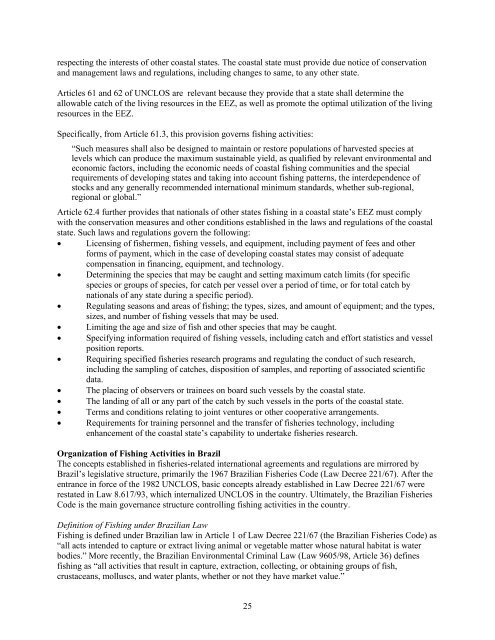Shrimp Farming in Brazil: An Industry Overview - Library - Network of ...
Shrimp Farming in Brazil: An Industry Overview - Library - Network of ...
Shrimp Farming in Brazil: An Industry Overview - Library - Network of ...
Create successful ePaper yourself
Turn your PDF publications into a flip-book with our unique Google optimized e-Paper software.
espect<strong>in</strong>g the <strong>in</strong>terests <strong>of</strong> other coastal states. The coastal state must provide due notice <strong>of</strong> conservation<br />
and management laws and regulations, <strong>in</strong>clud<strong>in</strong>g changes to same, to any other state.<br />
Articles 61 and 62 <strong>of</strong> UNCLOS are relevant because they provide that a state shall determ<strong>in</strong>e the<br />
allowable catch <strong>of</strong> the liv<strong>in</strong>g resources <strong>in</strong> the EEZ, as well as promote the optimal utilization <strong>of</strong> the liv<strong>in</strong>g<br />
resources <strong>in</strong> the EEZ.<br />
Specifically, from Article 61.3, this provision governs fish<strong>in</strong>g activities:<br />
“Such measures shall also be designed to ma<strong>in</strong>ta<strong>in</strong> or restore populations <strong>of</strong> harvested species at<br />
levels which can produce the maximum susta<strong>in</strong>able yield, as qualified by relevant environmental and<br />
economic factors, <strong>in</strong>clud<strong>in</strong>g the economic needs <strong>of</strong> coastal fish<strong>in</strong>g communities and the special<br />
requirements <strong>of</strong> develop<strong>in</strong>g states and tak<strong>in</strong>g <strong>in</strong>to account fish<strong>in</strong>g patterns, the <strong>in</strong>terdependence <strong>of</strong><br />
stocks and any generally recommended <strong>in</strong>ternational m<strong>in</strong>imum standards, whether sub-regional,<br />
regional or global.”<br />
Article 62.4 further provides that nationals <strong>of</strong> other states fish<strong>in</strong>g <strong>in</strong> a coastal state’s EEZ must comply<br />
with the conservation measures and other conditions established <strong>in</strong> the laws and regulations <strong>of</strong> the coastal<br />
state. Such laws and regulations govern the follow<strong>in</strong>g:<br />
• Licens<strong>in</strong>g <strong>of</strong> fishermen, fish<strong>in</strong>g vessels, and equipment, <strong>in</strong>clud<strong>in</strong>g payment <strong>of</strong> fees and other<br />
forms <strong>of</strong> payment, which <strong>in</strong> the case <strong>of</strong> develop<strong>in</strong>g coastal states may consist <strong>of</strong> adequate<br />
compensation <strong>in</strong> f<strong>in</strong>anc<strong>in</strong>g, equipment, and technology.<br />
• Determ<strong>in</strong><strong>in</strong>g the species that may be caught and sett<strong>in</strong>g maximum catch limits (for specific<br />
species or groups <strong>of</strong> species, for catch per vessel over a period <strong>of</strong> time, or for total catch by<br />
nationals <strong>of</strong> any state dur<strong>in</strong>g a specific period).<br />
• Regulat<strong>in</strong>g seasons and areas <strong>of</strong> fish<strong>in</strong>g; the types, sizes, and amount <strong>of</strong> equipment; and the types,<br />
sizes, and number <strong>of</strong> fish<strong>in</strong>g vessels that may be used.<br />
• Limit<strong>in</strong>g the age and size <strong>of</strong> fish and other species that may be caught.<br />
• Specify<strong>in</strong>g <strong>in</strong>formation required <strong>of</strong> fish<strong>in</strong>g vessels, <strong>in</strong>clud<strong>in</strong>g catch and effort statistics and vessel<br />
position reports.<br />
• Requir<strong>in</strong>g specified fisheries research programs and regulat<strong>in</strong>g the conduct <strong>of</strong> such research,<br />
<strong>in</strong>clud<strong>in</strong>g the sampl<strong>in</strong>g <strong>of</strong> catches, disposition <strong>of</strong> samples, and report<strong>in</strong>g <strong>of</strong> associated scientific<br />
data.<br />
• The plac<strong>in</strong>g <strong>of</strong> observers or tra<strong>in</strong>ees on board such vessels by the coastal state.<br />
• The land<strong>in</strong>g <strong>of</strong> all or any part <strong>of</strong> the catch by such vessels <strong>in</strong> the ports <strong>of</strong> the coastal state.<br />
• Terms and conditions relat<strong>in</strong>g to jo<strong>in</strong>t ventures or other cooperative arrangements.<br />
• Requirements for tra<strong>in</strong><strong>in</strong>g personnel and the transfer <strong>of</strong> fisheries technology, <strong>in</strong>clud<strong>in</strong>g<br />
enhancement <strong>of</strong> the coastal state’s capability to undertake fisheries research.<br />
Organization <strong>of</strong> Fish<strong>in</strong>g Activities <strong>in</strong> <strong>Brazil</strong><br />
The concepts established <strong>in</strong> fisheries-related <strong>in</strong>ternational agreements and regulations are mirrored by<br />
<strong>Brazil</strong>’s legislative structure, primarily the 1967 <strong>Brazil</strong>ian Fisheries Code (Law Decree 221/67). After the<br />
entrance <strong>in</strong> force <strong>of</strong> the 1982 UNCLOS, basic concepts already established <strong>in</strong> Law Decree 221/67 were<br />
restated <strong>in</strong> Law 8.617/93, which <strong>in</strong>ternalized UNCLOS <strong>in</strong> the country. Ultimately, the <strong>Brazil</strong>ian Fisheries<br />
Code is the ma<strong>in</strong> governance structure controll<strong>in</strong>g fish<strong>in</strong>g activities <strong>in</strong> the country.<br />
Def<strong>in</strong>ition <strong>of</strong> Fish<strong>in</strong>g under <strong>Brazil</strong>ian Law<br />
Fish<strong>in</strong>g is def<strong>in</strong>ed under <strong>Brazil</strong>ian law <strong>in</strong> Article 1 <strong>of</strong> Law Decree 221/67 (the <strong>Brazil</strong>ian Fisheries Code) as<br />
“all acts <strong>in</strong>tended to capture or extract liv<strong>in</strong>g animal or vegetable matter whose natural habitat is water<br />
bodies.” More recently, the <strong>Brazil</strong>ian Environmental Crim<strong>in</strong>al Law (Law 9605/98, Article 36) def<strong>in</strong>es<br />
fish<strong>in</strong>g as “all activities that result <strong>in</strong> capture, extraction, collect<strong>in</strong>g, or obta<strong>in</strong><strong>in</strong>g groups <strong>of</strong> fish,<br />
crustaceans, molluscs, and water plants, whether or not they have market value.”<br />
25

















